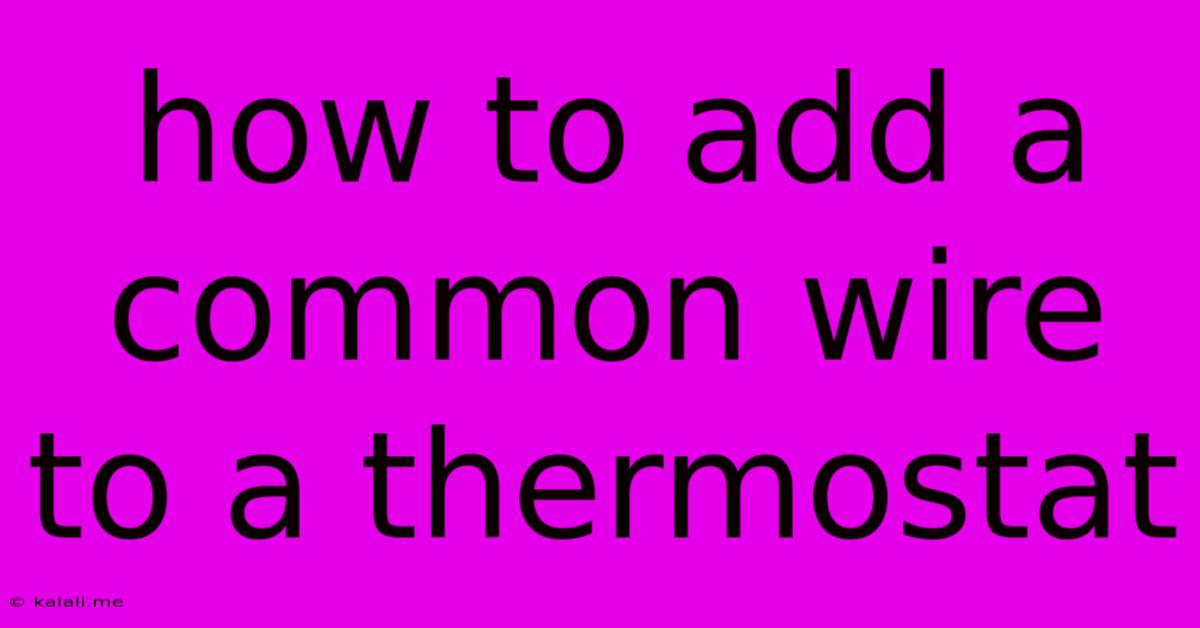How To Add A Common Wire To A Thermostat
Kalali
May 31, 2025 · 4 min read

Table of Contents
How to Add a Common Wire to a Thermostat: A Step-by-Step Guide
Meta Description: Learn how to easily add a common wire to your thermostat, resolving common heating and cooling system issues. This step-by-step guide provides clear instructions and safety precautions for a successful installation.
Adding a common wire to your thermostat is a relatively simple task that can solve a variety of problems, including inconsistent heating or cooling, system malfunctions, and even the inability to power the thermostat itself. This guide will walk you through the process, offering clear instructions and crucial safety precautions. Before you begin, remember that working with electrical systems can be dangerous. If you're not comfortable with electrical work, it's always best to consult a qualified HVAC technician.
Understanding the Common Wire
The common wire, often labeled "C" or "COM," provides a consistent power source to the thermostat. Without it, your thermostat may rely on power stolen from other wires, leading to inconsistent performance or complete failure. Many newer thermostats require a common wire for proper operation, especially smart thermostats and those with advanced features like Wi-Fi connectivity. Older systems might not have a common wire installed.
Tools and Materials You'll Need
- Wire strippers: To safely remove the insulation from the wire ends.
- Screwdrivers: To remove the thermostat cover and connect the wires. You'll likely need both Phillips and flathead screwdrivers.
- Low-voltage wire: Use a wire rated for low-voltage applications. The gauge (thickness) should match the existing wiring in your thermostat. A 22-gauge wire is often suitable.
- Wire connectors: These will securely join the new wire to your existing wiring. Wire nuts are a common and effective choice.
- Voltage tester (optional but recommended): To ensure power is off before working on the wiring.
- New thermostat (if necessary): If your current thermostat doesn't support a common wire, you may need to upgrade.
Step-by-Step Instructions
-
Turn off the power: This is the most crucial step. Locate your HVAC system's breaker and switch it to the "off" position. Use your voltage tester to confirm the power is off at the thermostat's wiring connections before proceeding.
-
Remove the thermostat: Carefully remove the thermostat from the wall plate. This usually involves unscrewing it or gently prying it loose.
-
Identify the existing wires: Examine the wires connected to your thermostat. Familiarize yourself with their colors and positions. Take pictures if it helps.
-
Run a new wire: You will need to run a new wire from the thermostat location to your furnace or air handler. This often involves carefully threading the wire through existing holes or conduits within your walls. This is often the most challenging step and may require additional tools depending on your home's construction. If you are not comfortable with this step, contact a professional.
-
Connect the common wire: Connect one end of your new low-voltage wire to the "C" terminal (or "COM") on your furnace or air handler. Secure this connection using a wire nut.
-
Connect the other end to the thermostat: At the thermostat, connect the other end of your new wire to the "C" terminal on the thermostat. Secure it with a wire nut or by using the terminal screws.
-
Reconnect the thermostat: Carefully tuck the wires back into the wall box and reattach the thermostat to the wall plate.
-
Turn the power back on: Switch the breaker back to the "on" position.
-
Test your system: Turn your heating or cooling system on to verify that everything is working correctly.
Troubleshooting
- Thermostat not powering on: Double-check your wire connections, ensure the power is on at the breaker, and verify the new common wire is securely connected at both ends.
- Inconsistent heating or cooling: Ensure all wire connections are secure and the correct wires are connected to the correct terminals.
- System errors: Consult your thermostat's manual for error codes and troubleshooting tips.
Adding a common wire might seem daunting, but following these steps carefully can make the process straightforward. Remember, safety is paramount, and if you encounter any difficulties, don't hesitate to call a qualified HVAC technician for assistance. This will ensure your system operates correctly and efficiently, preventing costly repairs down the line.
Latest Posts
Latest Posts
-
What To Do When A Teacher Doesnt Teach In University
Jun 02, 2025
-
Why Is My Friend Ignoring Me
Jun 02, 2025
-
How To Remove Tile From Cement Board
Jun 02, 2025
-
It Took Marie 10 Minutes To Saw A Board
Jun 02, 2025
-
Reflexive And Symmetric But Not Transitive
Jun 02, 2025
Related Post
Thank you for visiting our website which covers about How To Add A Common Wire To A Thermostat . We hope the information provided has been useful to you. Feel free to contact us if you have any questions or need further assistance. See you next time and don't miss to bookmark.